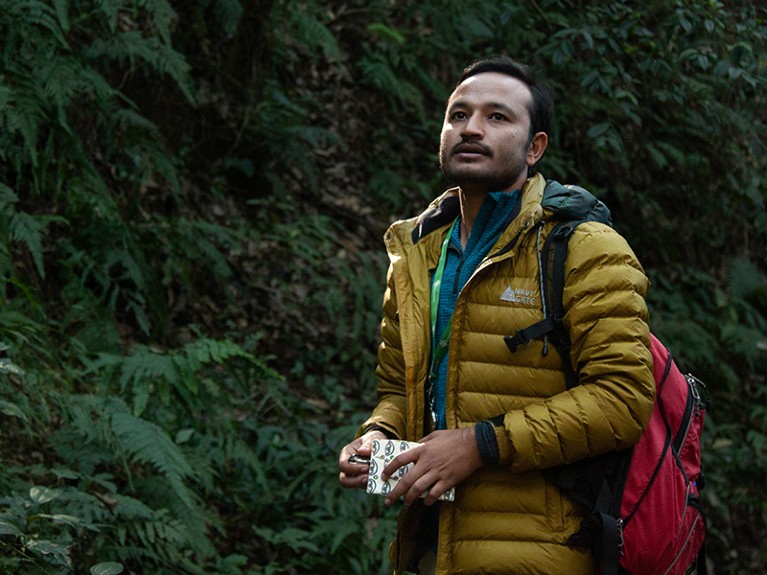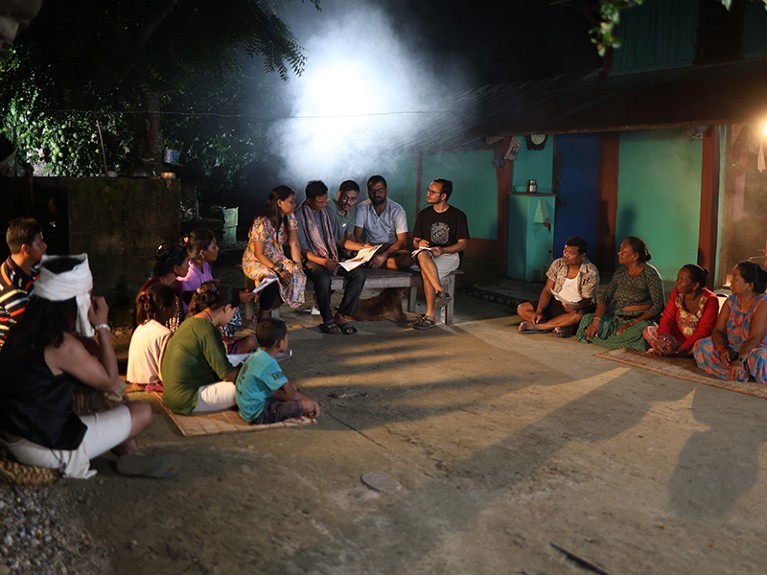
An advocate for endangered species both inside and outside the courtroom, Kumar Paudel tracks pangolins in central Nepal.Credit: Greenhood Nepal
As a child born and raised in Sindhupalchowk, a remote, hilly district northeast of Kathmandu, Kumar Paudel had heard plenty of stories about wildlife smuggling. The region is home to a major trade route exploited by smugglers trafficking wildlife from Nepal to China. He had seen people rapidly amass wealth through illegal trade of red sandalwood (Pterocarpus santalinus), pangolins and red pandas (Ailurus fulgens).
In 2010, while pursuing a bachelor’s degree in environmental science at Amrit Campus in Kathmandu, Paudel often encountered news about wildlife poaching, especially that of the endangered greater one-horned rhinoceros (Rhinoceros unicornis). He and his friends organized political protests and rallies, which resulted in improved parliamentary investigations into controlling wildlife poaching. Encouraged by their success, he co-founded Greenhood Nepal, a non-profit conservation organization based in Kathmandu that is dedicated to saving the country’s endangered flora and fauna. Paudel spoke to Nature about his study of the illegal wildlife trade, and how interviewing people who had been incarcerated for wildlife crimes inspired him to take his cause to Nepal’s highest court.
What led you to visit prisons as part of your conservation research?
When I started my master’s programme at the School of Environmental Science and Management in Kathmandu in 2012, I was already advocating for wildlife through public forums, writing newspaper opinion pieces and organizing outreach events. For my thesis, I connected all of these experiences to the smuggling cases in my home town, to explore the illegal trade route.
But reaching out directly to traders involved in an illegal business was challenging. I opted to visit prisons and talk with people serving sentences for wildlife poaching. I had a lot of questions: who were these people? Where do they come from? I later realized that most of them hailed from remote, marginalized communities, were from low-income families and lacked basic education. Many of them underestimated the social cost that their imprisonment would have on their families.
How did your master’s research evolve into advocacy?
While attending a wildlife-crime conference in South Africa in 2015, I met Jacob Phelps, a wildlife-trade researcher at Lancaster University, UK. Phelps was impressed that I was visiting prisons, and he advised me to expand the research into a nationwide study. I sampled seven prisons in the country and carried out in-depth interviews with 116 incarcerated people.
Visiting prisons and listening to the life stories of the people there helped me to connect with them and understand their struggles. In August 2016, I saw a preview of a television interview in which a former prime minister of Nepal displayed a large tiger pelt at his residence. The disparity struck me — the poorer people in prison had been convicted for their roles in the illegal wildlife trade, but the powerful could showcase parts of endangered animals on national television with no consequences.
What did you do about it?
I went to social media to ask for answers from enforcement agencies. I learnt that Nepal’s law clearly states that possession of wildlife parts without a registered licence is as illegal as trading protected animals. The law required any person possessing any protected wildlife parts to register them with the Department of National Parks and Wildlife Conservation. Surprisingly, when I checked in 2016, not a single person had done so.

Paudel teaches an Indigenous community in Chitwan, Nepal, about pangolin conservation.Credit: Greenhood Nepal
I repeatedly followed up with the Ministry of Forest and Environment, the Nepal Police and the Central Investigation Bureau. An officer at the environment ministry threatened me, saying that he could get me arrested if I kept pursuing the issue. I have to be honest: as a young researcher, I was scared. But after two years of getting no concrete answers, I sought legal action.
How did you prepare for a court battle?
Because I had been following up for nearly two years, I had a lot of evidence. I found an environmental lawyer — Padam Bahadur Shrestha, based in Kathmandu — who helped me to refine the petition and file it with the Nepal Supreme Court.
I knew that getting results out of the court system would be a frustrating process. I had heard about people who had waited decades for a decision. But I had no other options. My case garnered significant attention from lawyers and the public, because one of the judges who was supposed to hear it owned several wildlife parts.
My case went through 14 deferrals over five years. Last May, the Supreme Court finally heard my case. In my petition, I claimed that the government did not keep track of individuals who owned wildlife parts, and that the government was enforcing laws inequitably. The court acknowledged that my claim was valid and requested written answers from the government.
What arguments came up in the case?
The court extensively discussed one crucial matter: how law-enforcement bodies can intervene in matters related to people’s cultural beliefs. In Nepal, there is rich cultural diversity, and wildlife parts can hold cultural, religious and ancestral values. I defended my stance by emphasizing that, despite the parts’ symbolic meaning, wildlife is an important aspect of our biodiversity. Bringing the wildlife parts under a legal framework should help to deter illegal smuggling without hurting their historical and cultural significance.
What was the government’s response? Did the ruling change how wildlife laws are enforced?
The government acknowledged the failure to keep records of wildlife-part ownership. The court directed the government to take a proper accounting of who possessed such parts, including evidence for those in legal possession. It ordered the confiscation of illegally owned parts.
Although the issue has been politicized because it involved powerful people, the ruling set a precedent for the regulation of wildlife parts in private possession. The decision also supports enforcement officers, enabling them to pursue powerful figures if needed. The court order brings thousands of illegal wildlife parts under enforcement, regardless of who owns them.
What’s next for you?
I plan to continue working in conservation science and social justice, whether through courtroom battles or documentation of threatened species. Although conservation science is my main focus, I recognize the importance of translating theoretical discussions into the laws and policies that dictate how society operates. I hope that my case sets an example that there are times when researchers can transcend academic boundaries.

 How science bolstered a key European climate-change case
How science bolstered a key European climate-change case
 How I mixed microbiome research with public-health advocacy
How I mixed microbiome research with public-health advocacy
 Moving from prison to a PhD
Moving from prison to a PhD





